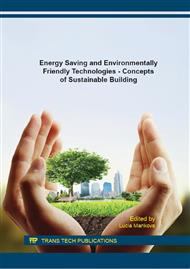[1]
Okten Suzan, Asan Ahmet; Airborne fungi and bacteria in indoor and outdoor environment of the Pediatric Unit of Edirne; Environ Monit Assess (2012) 184: 1739–1751; Springer Science+Business Media B.V. 2011; DOI 10. 1007/s10661-011-2075-x.
DOI: 10.1007/s10661-011-2075-x
Google Scholar
[2]
Yassin, M. F.; Almouqatea, S., (2010). Assessment of airborne bacteria and fungi in an indoor and outdoor environment. Int. J. Environ. Sci. Tech., 7 (3), 535-544.
DOI: 10.1007/bf03326162
Google Scholar
[3]
Górny RL, Reponen T, Willeke K, et al. Fungal Fragments as Indoor Air Biocontaminants. Applied and Environmental Microbiology. 2002; 68(7): 3522-3531. doi: 10. 1128/AEM. 68. 7. 3522-3531. (2002).
DOI: 10.1128/aem.68.7.3522-3531.2002
Google Scholar
[4]
D. Haas, J. Habib, J. Luxner, H. Galler, G. Zarfel, R. Schlacher, H. Friedl, F.F. Reinthaler: Comparison of background levels of culturable fungal spore concentrations in indoor and outdoor air in southeastern Austria; Atmospheric Environment 98 (2014).
DOI: 10.1016/j.atmosenv.2014.09.039
Google Scholar
[5]
Linlin Liang, Guenter Engling, Yuan Cheng, Fengkui Duan, Zhenyu Du, Kebin He; Rapid detection and quantification of fungal spores in the urban atmosphere by flow cytometry; Journal of Aerosol Science 66 (2013)179–186.
DOI: 10.1016/j.jaerosci.2013.08.013
Google Scholar
[6]
Lee, T., Grinshpun, S. A., Martuzevicius, D., Adhikari, A., Crawford, C. M., & Reponen, T. (2006).
Google Scholar
[7]
Hospodsky, D., Yamamoto, N., Nazaroff, W. W., Miller, D., Gorthala, S. and Peccia, J. (2014).
Google Scholar
[8]
Nazaroff, W. W. (2014), Indoor bioaerosol dynamics. Indoor Air. doi: 10. 1111/ina. 12174.
Google Scholar
[9]
Hayleeyesus, S. F., & Manaye, A. M. (2014). Microbiological Quality of Indoor Air in University Libraries. Asian Pacific Journal of Tropical Biomedicine, 4(Suppl 1), S312–S317. http: /doi. org/10. 12980/APJTB. 4. 2014C807.
DOI: 10.12980/apjtb.4.2014c807
Google Scholar
[10]
Celine M. O'Gorman, Hubert T. Fuller; Prevalence of culturable airborne spores of selected allergenic and pathogenic fungi in outdoor air; Atmospheric Environment 42 (2008), p.4355–4368.
DOI: 10.1016/j.atmosenv.2008.01.009
Google Scholar
[11]
Piecková, E.; Wilkins, K. 2004. Airway toxicity of house dust and fungal composition. Annals of Agricultural and Envi-ronmental Medicine, 11: 67–73.
Google Scholar


